Dipole Potential of Monolayers with Biologically Relevant Lipid Compositions
Abstract
1. Introduction
2. Results
2.1. Area per Lipid in Monolayers
2.2. Dipole Potential in Lipid Monolayers
3. Discussion
4. Materials and Methods
4.1. Materials
4.2. Monolayer Surface Pressure Experiments
4.3. Measurement of the Potential Difference Across Lipid Monolayers
Author Contributions
Funding
Institutional Review Board Statement
Informed Consent Statement
Data Availability Statement
Conflicts of Interest
References
- McLaughlin, S. Electrostatic Potentials at Membrane-Solution Interfaces. In Current Topics in Membranes and Transport; Bronner, F., Kleinzeller, A., Eds.; Academic Press: Cambridge, UK, 1977; Volume 9, pp. 71–144. [Google Scholar]
- Honig, B.H.; Hubbell, W.L.; Flewelling, R.F. Electrostatic Interactions In Membranes And Proteins. Annu. Rev. Biophys. 1986, 15, 163–193. [Google Scholar] [CrossRef] [PubMed]
- McLaughlin, S. The Electrostatic Properties of Membranes. Annu. Rev. Biophys. 1989, 18, 113–136. [Google Scholar] [CrossRef] [PubMed]
- Cevc, G. Membrane Electrostatics. Biochim. Biophys. Acta (BBA)—Rev. Biomembr. 1990, 1031, 311–382. [Google Scholar] [CrossRef]
- Liberman, E.A.; Topaly, V.P. Permeability Of Bimolecular Phospholipid Membranes For Fat-Soluble Ions. Biophys.-USSR 1969, 14, 452–461. [Google Scholar]
- Lairion, F.; Disalvo, E.A. Effect of Dipole Potential Variations on the Surface Charge Potential of Lipid Membranes. J. Phys. Chem. B 2009, 113, 1607–1614. [Google Scholar] [CrossRef] [PubMed]
- Gawrisch, K.; Ruston, D.; Zimmerberg, J.; Parsegian, V.A.; Rand, R.P.; Fuller, N. Membrane Dipole Potentials, Hydration Forces, and the Ordering of Water at Membrane Surfaces. Biophys. J. 1992, 61, 1213–1223. [Google Scholar] [CrossRef]
- Frias, M.A.; Cejas, J.P.; Rosa, A.S.; Disalvo, E.A. Relevance of Water in Biological Membranes. Chem. Phys. 2023, 566, 111784. [Google Scholar] [CrossRef]
- Li, S.; Wu, L.; Zhang, X.; Jiang, X. The Structure of Water Bonded to Phosphate Groups at the Electrified Zwitterionic Phospholipid Membranes/Aqueous Interface. Angew. Chem. Int. Ed. 2020, 59, 6627–6630. [Google Scholar] [CrossRef] [PubMed]
- Mai, T.L.; Derreumaux, P.; Nguyen, P.H. Structure and Elasticity of Mitochondrial Membranes: A Molecular Dynamics Simulation Study. J. Phys. Chem. B 2023, 127, 10778–10791. [Google Scholar] [CrossRef]
- Zhan, H.; Lazaridis, T. Influence of the Membrane Dipole Potential on Peptide Binding to Lipid Bilayers. Biophys. Chem. 2012, 161, 1–7. [Google Scholar] [CrossRef][Green Version]
- Cladera, J.; O’Shea, P. Intramembrane Molecular Dipoles Affect the Membrane Insertion and Folding of a Model Amphiphilic Peptide. Biophys. J. 1998, 74, 2434–2442. [Google Scholar] [CrossRef] [PubMed]
- Cardoso, R.M.S.; Martins, P.A.T.; Ramos, C.V.; Cordeiro, M.M.; Leote, R.J.B.; Razi Naqvi, K.; Vaz, W.L.C.; Moreno, M.J. Effect of Dipole Moment on Amphiphile Solubility and Partition into Liquid Ordered and Liquid Disordered Phases in Lipid Bilayers. Biochim. Biophys. Acta (BBA)—Biomembr. 2020, 1862, 183157. [Google Scholar] [CrossRef] [PubMed]
- Szabo, G. Dual Mechanism for the Action of Cholesterol on Membrane Permeability. Nature 1974, 252, 47–49. [Google Scholar] [CrossRef] [PubMed]
- Flewelling, R.F.; Hubbell, W.L. Hydrophobic Ion Interactions with Membranes. Thermodynamic Analysis of Tetraphenylphosphonium Binding to Vesicles. Biophys. J. 1986, 49, 531–540. [Google Scholar] [CrossRef]
- Filipe, H.A.L.; Loura, L.M.S.; Moreno, M.J. Permeation of a Homologous Series of NBD-Labeled Fatty Amines through Lipid Bilayers: A Molecular Dynamics Study. Membranes 2023, 13, 551. [Google Scholar] [CrossRef]
- Luchian, T.; Mereuta, L. Phlorizin- and 6-Ketocholestanol-Mediated Antagonistic Modulation of Alamethicin Activity in Phospholipid Planar Membranes. Langmuir 2006, 22, 8452–8457. [Google Scholar] [CrossRef]
- Pilotelle-Bunner, A.; Beaunier, P.; Tandori, J.; Maroti, P.; Clarke, R.J.; Sebban, P. The Local Electric Field within Phospholipid Membranes Modulates the Charge Transfer Reactions in Reaction Centres. Biochim. Biophys. Acta (BBA)—Bioenerg. 2009, 1787, 1039–1049. [Google Scholar] [CrossRef][Green Version]
- Amazon, J.J.; Feigenson, G.W. Lattice Simulations of Phase Morphology on Lipid Bilayers: Renormalization, Membrane Shape, and Electrostatic Dipole Interactions. Phys. Rev. E 2014, 89, 22702. [Google Scholar] [CrossRef]
- Clarke, R.J. Effect of Lipid Structure on the Dipole Potential of Phosphatidylcholine Bilayers. Biochim. Biophys. Acta (BBA)—Biomembr. 1997, 1327, 269–278. [Google Scholar] [CrossRef]
- Wang, L.; Bose, P.S.; Sigworth, F.J. Using Cryo-EM to Measure the Dipole Potential of a Lipid Membrane. Proc. Natl. Acad. Sci. USA 2006, 103, 18528–18533. [Google Scholar] [CrossRef]
- Almgren, M.; Gimel, J.C.; Wang, K.; Karlsson, G.; Edwards, K.; Brown, W.; Mortensen, K. SDS Micelles at High Ionic Strength. A Light Scattering, Neutron Scattering, Fluorescence Quenching, and CryoTEM Investigation. J. Colloid. Interface Sci. 1998, 202, 222–231. [Google Scholar] [CrossRef]
- Sarkar, P.; Chattopadhyay, A. Membrane Dipole Potential: An Emerging Approach to Explore Membrane Organization and Function. J. Phys. Chem. B 2022, 126, 4415–4430. [Google Scholar] [CrossRef]
- Brockman, H. Dipole Potential of Lipid Membranes. Chem. Phys. Lipids 1994, 73, 57–79. [Google Scholar] [CrossRef]
- Andersen, O.S.; Finkelstein, A.; Katz, I.; Cass, A. Effect of Phloretin on the Permeability of Thin Lipid Membranes. J. General. Physiol. 1976, 67, 749–771. [Google Scholar] [CrossRef]
- Franklin, J.C.; Cafiso, D.S. Internal Electrostatic Potentials in Bilayers: Measuring and Controlling Dipole Potentials in Lipid Vesicles. Biophys. J. 1993, 65, 289–299. [Google Scholar] [CrossRef] [PubMed]
- Simon, S.A.; McIntosh, T.J.; Magid, A.D.; Needham, D. Modulation of the Interbilayer Hydration Pressure by the Addition of Dipoles at the Hydrocarbon/Water Interface. Biophys. J. 1992, 61, 786–799. [Google Scholar] [CrossRef] [PubMed][Green Version]
- McIntosh, T.J.; Magid, A.D.; Simon, S.A. Cholesterol Modifies the Short-Range Repulsive Interactions between Phosphatidylcholine Membranes. Biochemistry 1989, 28, 17–25. [Google Scholar] [CrossRef]
- Smaby, J.M.; Brockman, H.L.; Brown, R.E. Cholesterol’s Interfacial Interactions with Sphingomyelins and-Phosphatidylcholines: Hydrocarbon Chain Structure Determines the Magnitude of Condensation. Biochemistry 1994, 33, 9135–9142. [Google Scholar] [CrossRef]
- Orlikowska-Rzeznik, H.; Versluis, J.; Bakker, H.J.; Piatkowski, L. Cholesterol Changes Interfacial Water Alignment in Model Cell Membranes. J. Am. Chem. Soc. 2024, 146, 13151–13162. [Google Scholar] [CrossRef]
- Pérez, H.A.; Disalvo, A.; Frías, M.d.l.Á. Effect of Cholesterol on the Surface Polarity and Hydration of Lipid Interphases as Measured by Laurdan Fluorescence: New Insights. Colloids Surf. B Biointerfaces 2019, 178, 346–351. [Google Scholar] [CrossRef]
- den Kamp, J.A.F. Lipid Asymmetry in Membranes. Annu. Rev. Biochem. 1979, 48, 47–71. [Google Scholar] [CrossRef] [PubMed]
- Devaux, P.F. Protein Involvement in Transmembrane Lipid. Annu. Rev. Biophys. 1992, 21, 417–439. [Google Scholar] [CrossRef] [PubMed]
- Rothman, J.E.; Lenard, J. Membrane Asymmetry. Science (1979) 1977, 195, 743–753. [Google Scholar] [CrossRef] [PubMed]
- Leidl, K.; Liebisch, G.; Richter, D.; Schmitz, G. Mass Spectrometric Analysis of Lipid Species of Human Circulating Blood Cells. Biochim. Biophys. Acta (BBA)—Mol. Cell Biol. Lipids 2008, 1781, 655–664. [Google Scholar] [CrossRef]
- Dodge, J.T.; Phillips, G.B. Composition of Phospholipids and of Phospholipid Fatty Acids and Aldehydes in Human Red Cells. J. Lipid Res. 1967, 8, 667–675. [Google Scholar] [CrossRef]
- Verkleij, A.J.; Zwaal, R.F.A.; Roelofsen, B.; Comfurius, P.; Kastelijn, D.; van Deenen, L.L.M. The Asymmetric Distribution of Phospholipids in the Human Red Cell Membrane. A Combined Study Using Phospholipases and Freeze-Etch Electron Microscopy. Biochim. Biophys. Acta (BBA)—Biomembr. 1973, 323, 178–193. [Google Scholar] [CrossRef]
- Kiessling, V.; Wan, C.; Tamm, L.K. Domain Coupling in Asymmetric Lipid Bilayers. Biochim. Biophys. Acta (BBA)—Biomembr. 2009, 1788, 64–71. [Google Scholar] [CrossRef] [PubMed]
- Starke-Peterkovic, T.; Turner, N.; Vitha, M.F.; Waller, M.P.; Hibbs, D.E.; Clarke, R.J. Cholesterol Effect on the Dipole Potential of Lipid Membranes. Biophys. J. 2006, 90, 4060–4070. [Google Scholar] [CrossRef]
- Falkovich, S.G.; Martinez-Seara, H.; Nesterenko, A.M.; Vattulainen, I.; Gurtovenko, A.A. What Can We Learn about Cholesterol’s Transmembrane Distribution Based on Cholesterol-Induced Changes in Membrane Dipole Potential? J. Phys. Chem. Lett. 2016, 7, 4585–4590. [Google Scholar] [CrossRef]
- Shen, H.; Deng, M.; Wu, Z.; Zhang, J.; Zhang, Y.; Gao, C.; Cen, C. Effect of Cholesterol on Membrane Dipole Potential: Atomistic and Coarse-Grained Molecular Dynamics Simulations. J. Chem. Theory Comput. 2018, 14, 3780–3795. [Google Scholar] [CrossRef]
- Oakes, V.; Domene, C. Stereospecific Interactions of Cholesterol in a Model Cell Membrane: Implications for the Membrane Dipole Potential. J. Membr. Biol. 2018, 251, 507–519. [Google Scholar] [CrossRef] [PubMed]
- Clarke, R.J. Effect of Cholesterol on the Dipole Potential of Lipid Membranes. In Cholesterol Modulation of Protein Function: Sterol Specificity and Indirect Mechanisms; Rosenhouse-Dantsker, A., Bukiya, A.N., Eds.; Springer International Publishing: Cham, Switzerland, 2019; pp. 135–154. ISBN 978-3-030-04278-3. [Google Scholar]
- Zakany, F.; Kovacs, T.; Panyi, G.; Varga, Z. Direct and Indirect Cholesterol Effects on Membrane Proteins with Special Focus on Potassium Channels. Biochim. Biophys. Acta (BBA)—Mol. Cell Biol. Lipids 2020, 1865, 158706. [Google Scholar] [CrossRef] [PubMed]
- Martins, P.T.; Velazquez-Campoy, A.; Vaz, W.L.C.; Cardoso, R.M.S.; Valério, J.; Moreno, M.J. Kinetics and Thermodynamics of Chlorpromazine Interaction with Lipid Bilayers: Effect of Charge and Cholesterol. J. Am. Chem. Soc. 2012, 134, 4184–4195. [Google Scholar] [CrossRef] [PubMed]
- Sampaio, J.L.; Moreno, M.J.; Vaz, W.L.C. Kinetics and Thermodynamics of Association of a Fluorescent Lysophospholipid Derivative with Lipid Bilayers in Liquid-Ordered and Liquid-Disordered Phases. Biophys. J. 2005, 88, 4064–4071. [Google Scholar] [CrossRef][Green Version]
- Coreta-Gomes, F.M.; Vaz, W.L.C.; Moreno, M.J. Effect of Acyl Chain Length on the Rate of Phospholipid Flip-Flop and Intermembrane Transfer. J. Membr. Biol. 2018, 251, 431–442. [Google Scholar] [CrossRef]
- Oliveira, A.C.; Filipe, H.A.L.; Geraldes, C.F.G.C.; Voth, G.A.; Moreno, M.J.; Loura, L.M.S. Interaction of MRI Contrast Agent [Gd(DOTA)]− with Lipid Membranes: A Molecular Dynamics Study. Inorg. Chem. 2024, 63, 10897–10914. [Google Scholar] [CrossRef]
- Cordeiro, M.M.; Filipe, H.A.L.; Santos, P.d.; Samelo, J.; Ramalho, J.P.P.; Loura, L.M.S.; Moreno, M.J. Interaction of Hoechst 33342 with POPC Membranes at Different PH Values. Molecules 2023, 28, 5640. [Google Scholar] [CrossRef]
- Magalhães, N.; Simões, G.M.; Ramos, C.; Samelo, J.; Oliveira, A.C.; Filipe, H.A.L.; Ramalho, J.P.P.; Moreno, M.J.; Loura, L.M.S. Interactions between Rhodamine Dyes and Model Membrane Systems—Insights from Molecular Dynamics Simulations. Molecules 2022, 27, 1420. [Google Scholar] [CrossRef]
- Estronca, L.M.B.B.; João Moreno, M.; Abreu, M.S.C.; Melo, E.; Vaz, W.L.C. Solubility of Amphiphiles in Membranes: Influence of Phase Properties and Amphiphile Head Group. Biochem. Biophys. Res. Commun. 2002, 296, 596–603. [Google Scholar] [CrossRef] [PubMed][Green Version]
- Cejas, J.D.P.; Rosa, A.S.; González Paz, A.N.; Disalvo, E.A.; Frías, M.d.l.A. Impact of Chlorogenic Acid on Surface and Phase Properties of Cholesterol-Enriched Phosphatidylcholine Membranes. Arch. Biochem. Biophys. 2024, 753, 109913. [Google Scholar] [CrossRef]
- Taylor, G.; Nguyen, M.-A.; Koner, S.; Freeman, E.; Collier, C.P.; Sarles, S.A. Electrophysiological Interrogation of Asymmetric Droplet Interface Bilayers Reveals Surface-Bound Alamethicin Induces Lipid Flip-Flop. Biochim. Biophys. Acta (BBA)—Biomembr. 2019, 1861, 335–343. [Google Scholar] [CrossRef] [PubMed]
- Li, S.; Wu, L.; Zhu, M.; Cheng, X.; Jiang, X. Effect of Dipole Potential on the Orientation of Voltage-Gated Alamethicin Peptides Regulated by Chaotropic Anions. J. Electroanal. Chem. 2022, 904, 115880. [Google Scholar] [CrossRef]
- de Matos, A.M.; Blázquez-Sánchez, M.T.; Sousa, C.; Oliveira, M.C.; de Almeida, R.F.M.; Rauter, A.P. C-Glucosylation as a Tool for the Prevention of PAINS-Induced Membrane Dipole Potential Alterations. Sci. Rep. 2021, 11, 4443. [Google Scholar] [CrossRef]
- Pohl, E.E.; Krylov, A.V.; Block, M.; Pohl, P. Changes of the Membrane Potential Profile Induced by Verapamil and Propranolol. Biochim. Biophys. Acta (BBA)—Biomembr. 1998, 1373, 170–178. [Google Scholar] [CrossRef]
- Cafiso, D.S. Dipole Potentials and Spontaneous Curvature: Membrane Properties That Could Mediate Anesthesia. Toxicol. Lett. 1998, 100–101, 431–439. [Google Scholar] [CrossRef]
- Paiva, T.O.; Bastos, A.E.P.; Marquês, J.T.; Viana, A.S.; Lima, P.A.; de Almeida, R.F.M. M-Cresol Affects the Lipid Bilayer in Membrane Models and Living Neurons. RSC Adv. 2016, 6, 105699–105712. [Google Scholar] [CrossRef]
- Clarke, R.J. Dipole-Potential-Mediated Effects on Ion Pump Kinetics. Biophys. J. 2015, 109, 1513–1520. [Google Scholar] [CrossRef]
- Maggio, B. Modulation of Phospholipase A2 by Electrostatic Fields and Dipole Potential of Glycosphingolipids in Monolayers. J. Lipid Res. 1999, 40, 930–939. [Google Scholar] [CrossRef] [PubMed]
- Marsh, D. Lateral Pressure in Membranes. Biochim. Biophys. Acta (BBA)—Rev. Biomembr. 1996, 1286, 183–223. [Google Scholar] [CrossRef]
- Lantzsch, G.; Binder, H.; Heerklotz, H. Surface Area per Molecule in Lipid/C12Enmembranes as Seen by Fluorescence Resonance Energy Transfer. J. Fluoresc. 1994, 4, 339–343. [Google Scholar] [CrossRef]
- König, B.; Dietrich, U.; Klose, G. Hydration and Structural Properties of Mixed Lipid/Surfactant Model Membranes. Langmuir 1997, 13, 525–532. [Google Scholar] [CrossRef]
- Mukhopadhyay, P.; Monticelli, L.; Tieleman, D.P. Molecular Dynamics Simulation of a Palmitoyl-Oleoyl Phosphatidylserine Bilayer with Na+ Counterions and NaCl. Biophys. J. 2004, 86, 1601–1609. [Google Scholar] [CrossRef]
- Rand, R.P.; Parsegian, V.A. Hydration Forces between Phospholipid Bilayers. Biochim. Biophys. Acta (BBA)—Rev. Biomembr. 1989, 988, 351–376. [Google Scholar] [CrossRef]
- Smaby, J.M.; Momsen, M.M.; Brockman, H.L.; Brown, R.E. Phosphatidylcholine Acyl Unsaturation Modulates the Decrease in Interfacial Elasticity Induced by Cholesterol. Biophys. J. 1997, 73, 1492–1505. [Google Scholar] [CrossRef]
- Smaby, J.M.; Brockman, H.L. Surface Dipole Moments of Lipids at the Argon-Water Interface. Similarities among Glycerol-Ester-Based Lipids. Biophys. J. 1990, 58, 195–204. [Google Scholar] [CrossRef]
- MacDonald, R.C.; Simon, S.A. Lipid Monolayer States and Their Relationships to Bilayers. Proc. Natl. Acad. Sci. USA 1987, 84, 4089–4093. [Google Scholar] [CrossRef]
- Taylor, D.M.; De Oliveira, O.N.; Morgan, H. Models for Interpreting Surface Potential Measurements and Their Application to Phospholipid Monolayers. J. Colloid. Interface Sci. 1990, 139, 508–518. [Google Scholar] [CrossRef]
- MacDonald, R.C.; Simon, S.A.; Baer, E. Ionic Influences on the Phase Transition of Dipalmitoylphosphatidylserine. Biochemistry 1976, 15, 885–891. [Google Scholar] [CrossRef]
- Ding, W.; Palaiokostas, M.; Wang, W.; Orsi, M. Effects of Lipid Composition on Bilayer Membranes Quantified by All-Atom Molecular Dynamics. J. Phys. Chem. B 2015, 119, 15263–15274. [Google Scholar] [CrossRef]
- McIntosh, T.J.; Simon, S.A.; Needham, D.; Huang, C.H. Interbilayer Interactions between Sphingomyelin and Sphingomyelin/Cholesterol Bilayers. Biochemistry 1992, 31, 2020–2024. [Google Scholar] [CrossRef]
- Lund-Katz, S.; Laboda, H.M.; McLean, L.R.; Phillips, M.C. Influence of Molecular Packing and Phospholipid Type on Rates of Cholesterol Exchange. Biochemistry 1988, 27, 3416–3423. [Google Scholar] [CrossRef] [PubMed]
- Shahane, G.; Ding, W.; Palaiokostas, M.; Orsi, M. Physical Properties of Model Biological Lipid Bilayers: Insights from All-Atom Molecular Dynamics Simulations. J. Mol. Model. 2019, 25, 76. [Google Scholar] [CrossRef] [PubMed]
- McIntosh, T.J.; Simon, S.A.; Needham, D.; Huang, C.H. Structure and Cohesive Properties of Sphingomyelin/Cholesterol Bilayers. Biochemistry 1992, 31, 2012–2020. [Google Scholar] [CrossRef] [PubMed]
- Niemelä, P.; Hyvönen, M.T.; Vattulainen, I. Structure and Dynamics of Sphingomyelin Bilayer: Insight Gained through Systematic Comparison to Phosphatidylcholine. Biophys. J. 2004, 87, 2976–2989. [Google Scholar] [CrossRef]
- Chiu, S.W.; Vasudevan, S.; Jakobsson, E.; Mashl, R.J.; Scott, H.L. Structure of Sphingomyelin Bilayers: A Simulation Study. Biophys. J. 2003, 85, 3624–3635. [Google Scholar] [CrossRef]
- Cevc, G.; Watts, A.; Marsh, D. Titration of the Phase Transition of Phosphatidylserine Bilayer Membranes. Effects of PH, Surface Electrostatics, Ion Binding, and Head-Group Hydration. Biochemistry 1981, 20, 4955–4965. [Google Scholar] [CrossRef]
- Tsui, F.C.; Ojcius, D.M.; Hubbell, W.L. The Intrinsic PKa Values for Phosphatidylserine and Phosphatidylethanolamine in Phosphatidylcholine Host Bilayers. Biophys. J. 1986, 49, 459–468. [Google Scholar] [CrossRef]
- Seelig, A. Local Anesthetics and Pressure: A Comparison of Dibucaine Binding to Lipid Monolayers and Bilayers. Biochim. Biophys. Acta (BBA)—Biomembr. 1987, 899, 196–204. [Google Scholar] [CrossRef]
- Blume, A. A Comparative Study of the Phase Transitions of Phospholipid Bilayers and Monolayers. Biochim. Biophys. Acta (BBA)—Biomembr. 1979, 557, 32–44. [Google Scholar] [CrossRef]
- Demel, R.A.; Geurts van Kessel, W.S.M.; Zwaal, R.F.A.; Roelofsen, B.; van Deenen, L.L.M. Relation between Various Phospholipase Actions on Human Red Cell Membranes and the Interfacial Phospholipid Pressure in Monolayers. Biochim. Biophys. Acta (BBA)—Biomembr. 1975, 406, 97–107. [Google Scholar] [CrossRef]
- Marsh, D. Handbook of Lipid Bilayers, 2nd ed.; CRC Press: Boca Raton, FL, USA, 2013. [Google Scholar]
- Müller-Landau, F.; Cadenhead, D.A. Molecular Packing in Steroid-Lecithin Monolayers, Part I: Pure Films of Cholesterol, 3-Doxyl-Cholestane, 3-Doxyl-17-Hydroxyl-Androstane, Tetradecanoic Acid and Dipalmitoyl-Phosphatidylcholine. Chem. Phys. Lipids 1979, 25, 299–314. [Google Scholar] [CrossRef]
- Huang, J.; Swanson, J.E.; Dibble, A.R.; Hinderliter, A.K.; Feigenson, G.W. Nonideal Mixing of Phosphatidylserine and Phosphatidylcholine in the Fluid Lamellar Phase. Biophys. J. 1993, 64, 413–425. [Google Scholar] [CrossRef]
- Li, X.-M.; Ramakrishnan, M.; Brockman, H.L.; Brown, R.E.; Swamy, M.J. N-Myristoylated Phosphatidylethanolamine: Interfacial Behavior and Interaction with Cholesterol. Langmuir 2002, 18, 231–238. [Google Scholar] [CrossRef] [PubMed][Green Version]
- Suades, A.; Qureshi, A.; McComas, S.E.; Coinçon, M.; Rudling, A.; Chatzikyriakidou, Y.; Landreh, M.; Carlsson, J.; Drew, D. Establishing Mammalian GLUT Kinetics and Lipid Composition Influences in a Reconstituted-Liposome System. Nat. Commun. 2023, 14, 4070. [Google Scholar] [CrossRef] [PubMed]
- Hresko, R.C.; Kraft, T.E.; Quigley, A.; Carpenter, E.P.; Hruz, P.W. Mammalian Glucose Transporter Activity Is Dependent upon Anionic and Conical Phospholipids*. J. Biol. Chem. 2016, 291, 17271–17282. [Google Scholar] [CrossRef]
- Clarke, R.J.; Hossain, K.R.; Cao, K. Physiological Roles of Transverse Lipid Asymmetry of Animal Membranes. Biochim. Biophys. Acta (BBA)—Biomembr. 2020, 1862, 183382. [Google Scholar] [CrossRef]
- Kol, M.A.; de Kroon, A.I.P.M.; Killian, J.A.; de Kruijff, B. Transbilayer Movement of Phospholipids in Biogenic Membranes. Biochemistry 2004, 43, 2673–2681. [Google Scholar] [CrossRef]
- van Meer, G.; Voelker, D.R.; Feigenson, G.W. Membrane Lipids: Where They Are and How They Behave. Nat. Rev. Mol. Cell Biol. 2008, 9, 112–124. [Google Scholar] [CrossRef] [PubMed]
- Moreno, M.J.; Estronca, L.M.B.B.; Vaz, W.L.C. Translocation of Phospholipids and Dithionite Permeability in Liquid-Ordered and Liquid-Disordered Membranes. Biophys. J. 2006, 91, 873–881. [Google Scholar] [CrossRef]
- Latorre, R.; Hall, J.E. Dipole Potential Measurements in Asymmetric Membranes. Nature 1976, 264, 361–363. [Google Scholar] [CrossRef]
- Gurtovenko, A.A.; Vattulainen, I. Lipid Transmembrane Asymmetry and Intrinsic Membrane Potential: Two Sides of the Same Coin. J. Am. Chem. Soc. 2007, 129, 5358–5359. [Google Scholar] [CrossRef] [PubMed]
- Lorent, J.H.; Levental, K.R.; Ganesan, L.; Rivera-Longsworth, G.; Sezgin, E.; Doktorova, M.; Lyman, E.; Levental, I. Plasma Membranes Are Asymmetric in Lipid Unsaturation, Packing and Protein Shape. Nat. Chem. Biol. 2020, 16, 644–652. [Google Scholar] [CrossRef] [PubMed]
- Pabst, G.; Keller, S. Exploring Membrane Asymmetry and Its Effects on Membrane Proteins. Trends Biochem. Sci. 2024, 49, 333–345. [Google Scholar] [CrossRef] [PubMed]
- Horowicz, P.; Schneider, M.F. Membrane Charge Moved at Contraction Thresholds in Skeletal Muscle Fibres. J. Physiol. 1981, 314, 595–633. [Google Scholar] [CrossRef]
- Quiñonez, M.; González, F.; Morgado-Valle, C.; DiFranco, M. Effects of Membrane Depolarization and Changes in Extracellular [K+] on the Ca2+ Transients of Fast Skeletal Muscle Fibers. Implications for Muscle Fatigue. J. Muscle Res. Cell Motil. 2010, 31, 13–33. [Google Scholar] [CrossRef]
- McCormick, D.A. Chapter 12—Membrane Potential and Action Potential. In From Molecules to Networks, 3rd ed.; Byrne, J.H., Heidelberger, R., Waxham, M.N., Eds.; Academic Press: Boston, MA, USA, 2014; pp. 351–376. ISBN 978-0-12-397179-1. [Google Scholar]
- Schlegel, R.A.; Williamson, P. Phosphatidylserine, a Death Knell. Cell Death Differ. 2001, 8, 551–563. [Google Scholar] [CrossRef]
- Mourdjeva, M.; Kyurkchiev, D.; Mandinova, A.; Altankova, I.; Kehayov, I.; Kyurkchiev, S. Dynamics of Membrane Translocation of Phosphatidylserine during Apoptosis Detected by a Monoclonal Antibody. Apoptosis 2005, 10, 209–217. [Google Scholar] [CrossRef]
- Chaurio, R.A.; Janko, C.; Muñoz, L.E.; Frey, B.; Herrmann, M.; Gaipl, U.S. Phospholipids: Key Players in Apoptosis and Immune Regulation. Molecules 2009, 14, 4892–4914. [Google Scholar] [CrossRef] [PubMed]
- Lee, K.-D.; Hong, K.; Papahadjopoulos, D. Recognition of Liposomes by Cells: In Vitro Binding and Endocytosis Mediated by Specific Lipid Headgroups and Surface Charge Density. Biochim. Biophys. Acta (BBA)—Biomembr. 1992, 1103, 185–197. [Google Scholar] [CrossRef]
- Luzardo, M.d.C.; Peltzer, G.; Disalvo, E.A. Surface Potential of Lipid Interfaces Formed by Mixtures of Phosphatidylcholine of Different Chain Lengths. Langmuir 1998, 14, 5858–5862. [Google Scholar] [CrossRef]
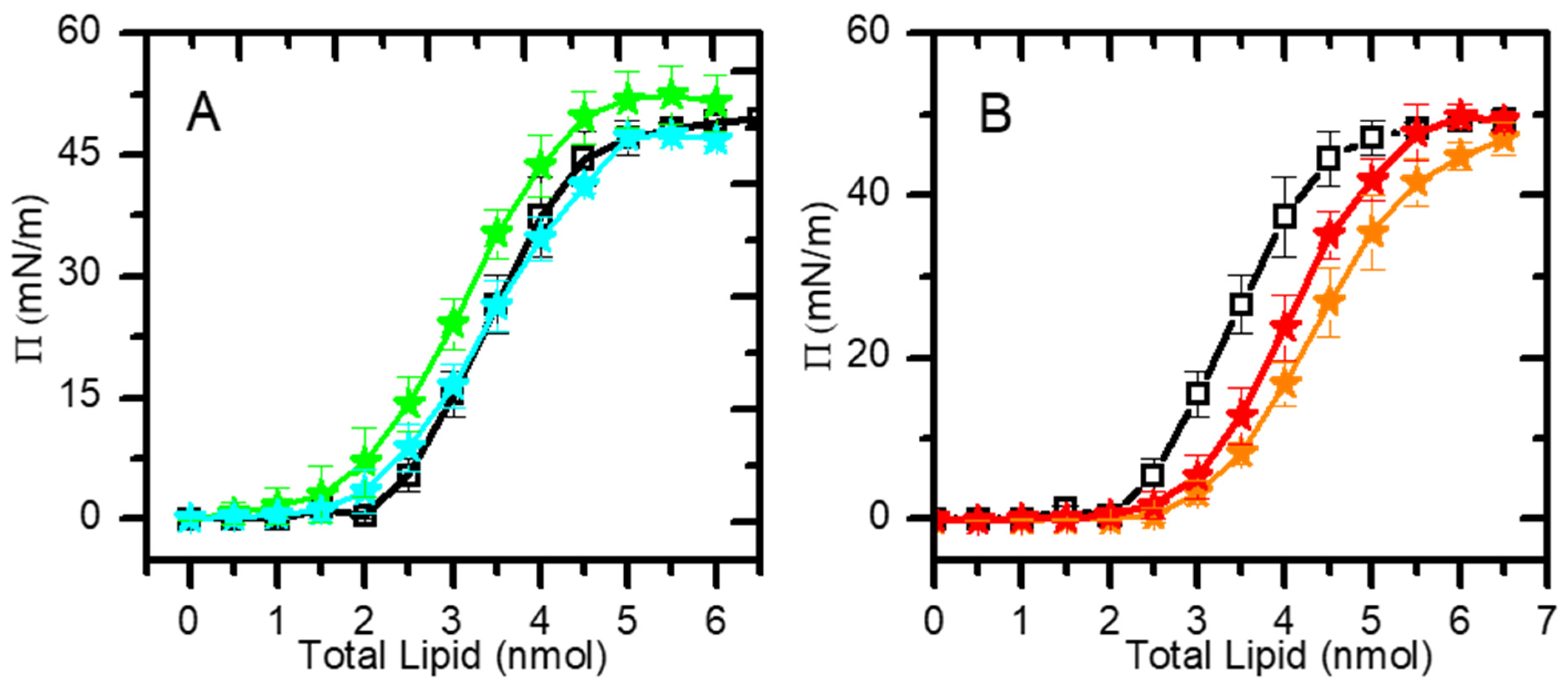

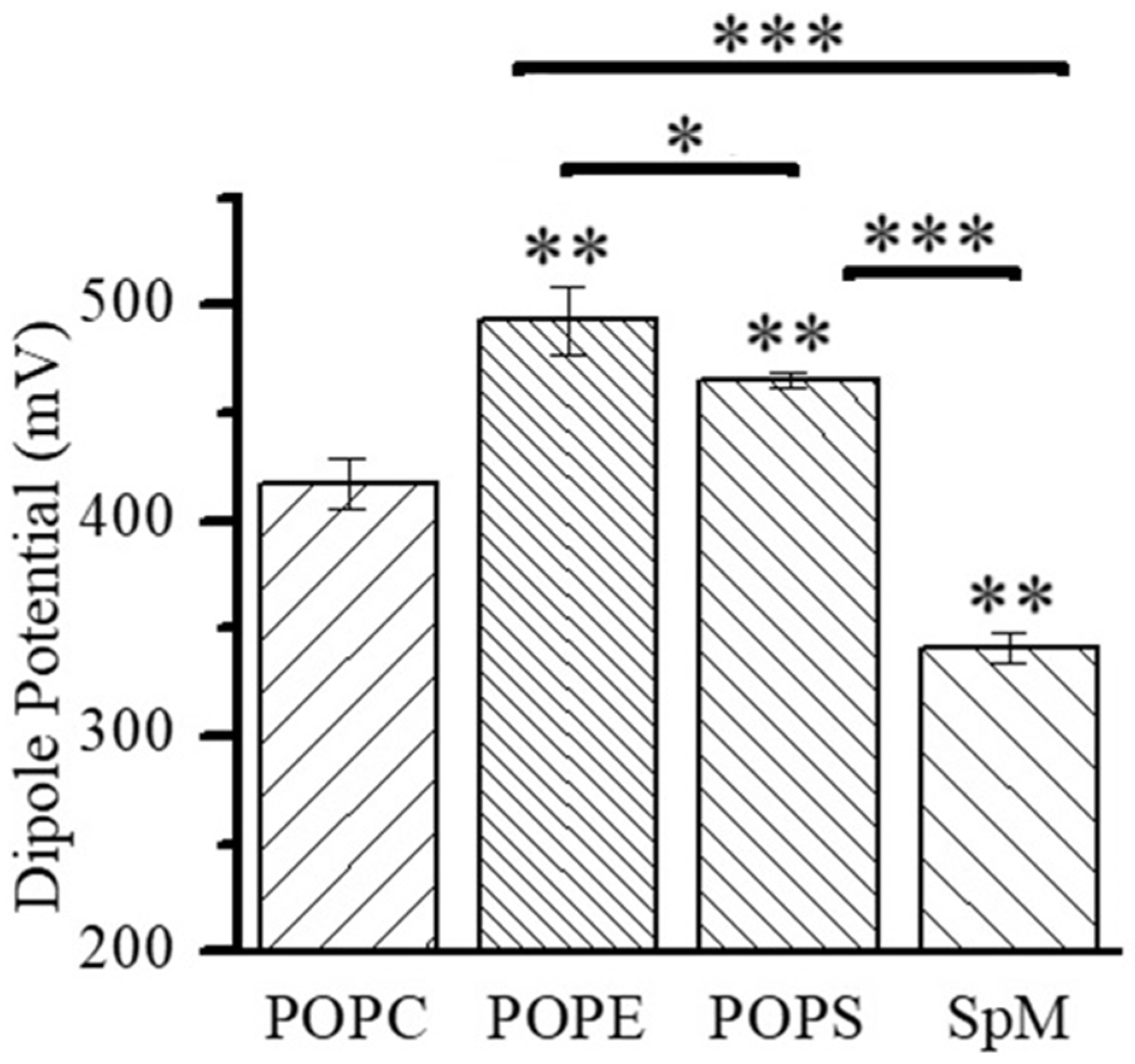
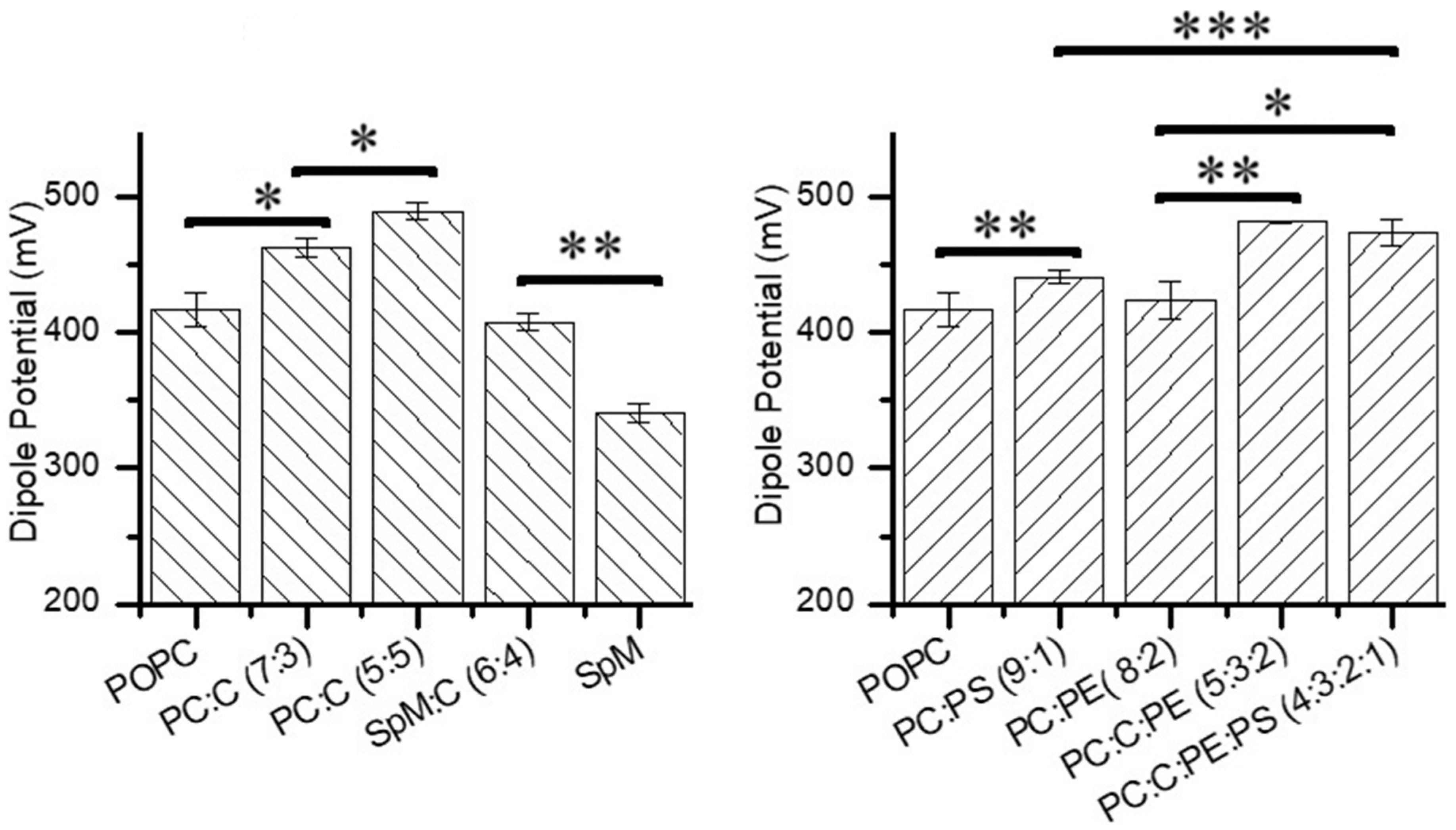
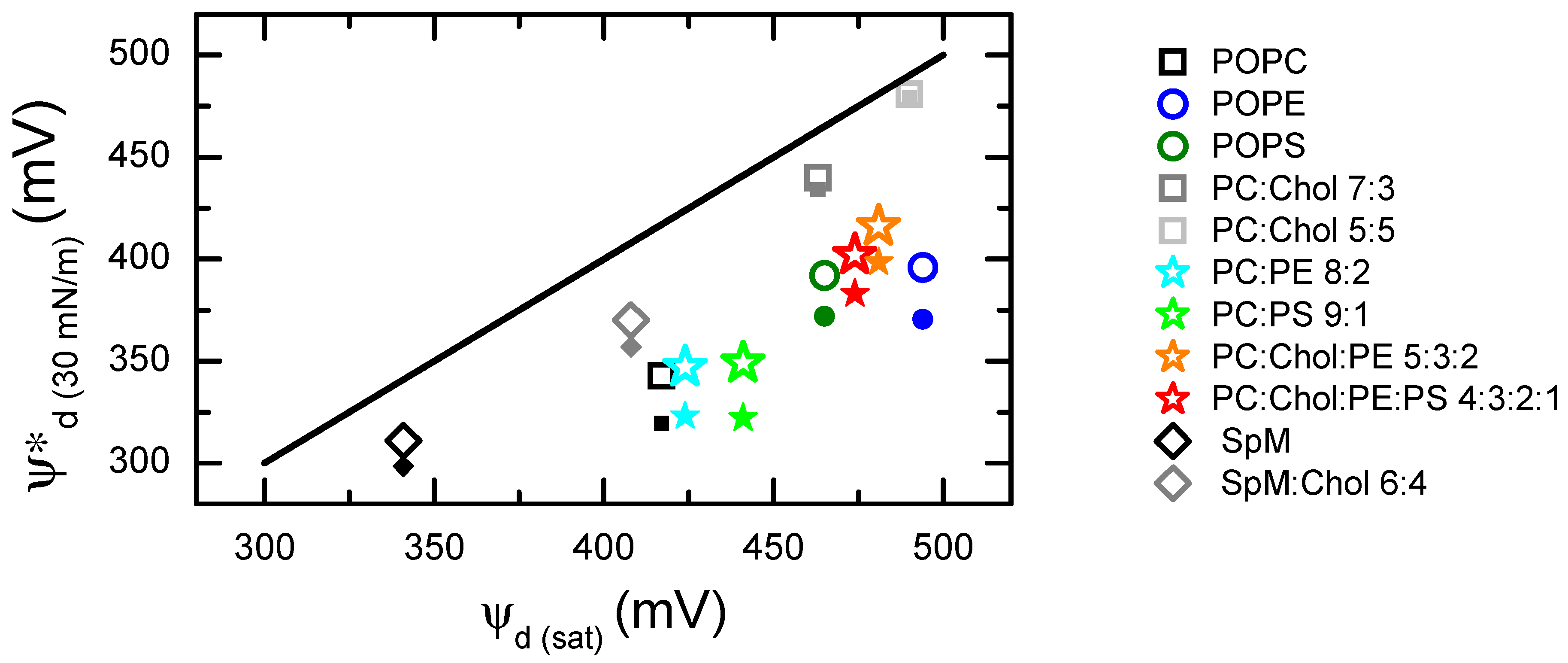


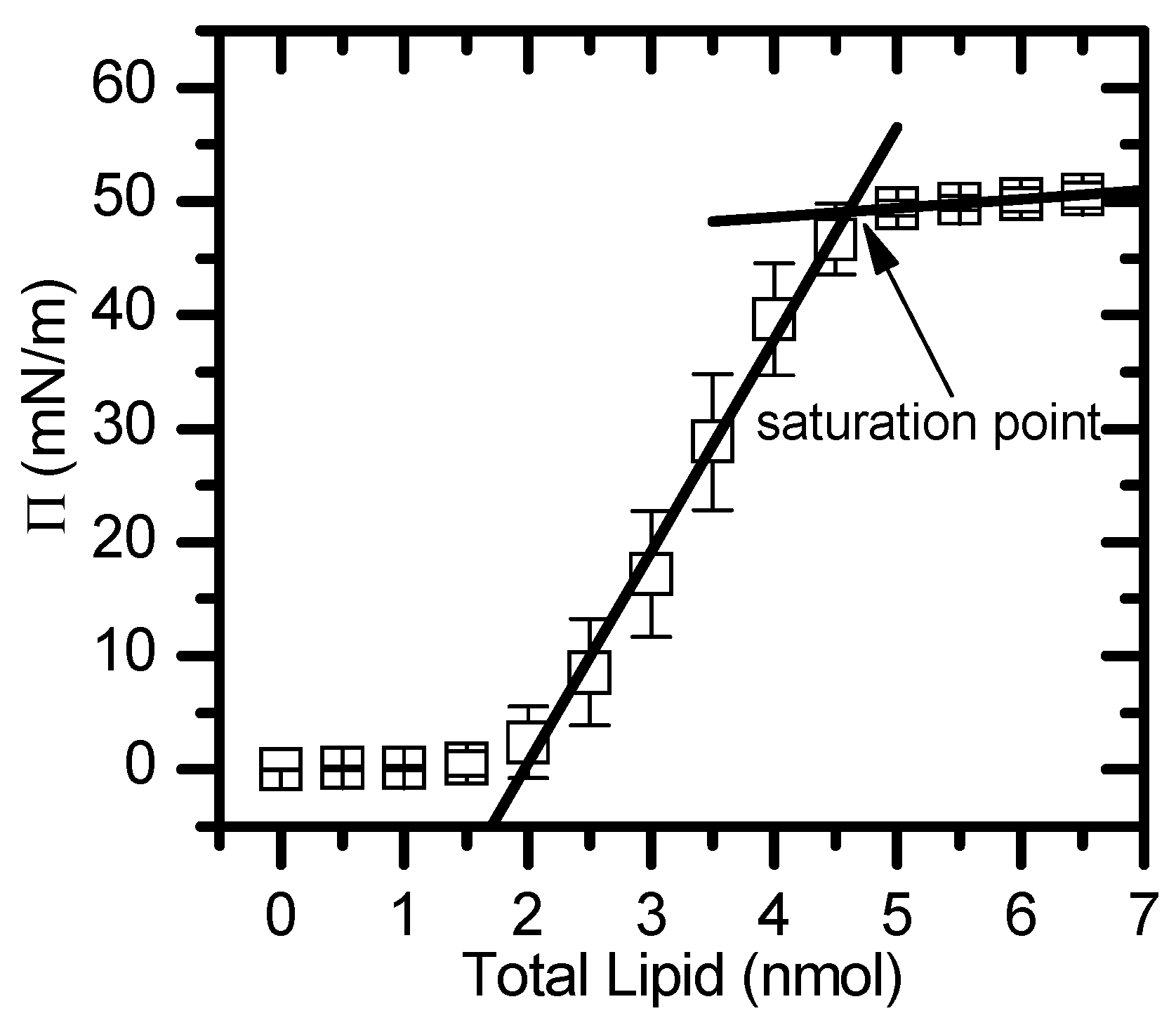
| Area per Lipid at π = 30 mN/m (Å2) | Area per Lipid at πsat (Å2) | Saturation Pressure (mN/m) | Dipole Potential at πsat (mV) | |
|---|---|---|---|---|
| POPC | 64.5 | 49.4 ± 3.4 | 50 | 417 ± 12 |
| POPS | 55.0 a | 44 f | - | 465 ± 4.2 e |
| POPE | 56.0 b | 42 f | - | 494 ± 16 |
| SPM | 48.0 c | 42 c | - | 341 ± 7.1 |
| POPC:POPS (9:1) | 69.8 | 51.0 ± 4.0 | 51 | 441 ± 2.5 e |
| POPC:POPE (8:2) | 59.6 | 45.4 ± 3.0 | 47 | 424 ± 15 |
| POPC:CHOL (7:3) | 48.0 d | 45 d | - | 463 ± 6.9 |
| POPC:CHOL (5:5) | 44.0 d | 43 d | - | 490 ± 5.7 |
| POPC:CHOL:POPE (5:3:2) | 56.0 | 46.4 ± 2.7 | 46 | 481 ± 1.4 |
| POPC:CHOL:POPE:POPS (4:3:2:1) Inner | 61.5 | 49.7 ± 2.6 | 49 | 474 ± 11 e |
| SPM:CHOL (6:4) outer | 39.0 c | - | - | 408 ± 6.3 |
| Equation (1) | Equation (2) | |||
|---|---|---|---|---|
| (mD) | (mV) | (mD) | (mV) | |
| POPC | 546 | 319 | 415 | 343 |
| POPS | 543 | 372 | 426 | 392 |
| POPE | 550 | 371 | 439 | 396 |
| SPM | 380 | 298 | 268 | 311 |
| POPC:POPS (9:1) | 597 | 322 | 461 | 349 |
| POPC:POPE (8:2) | 511 | 323 | 390 | 347 |
| POPC:CHOL (7:3) | 553 | 434 | 433 | 440 |
| POPC:CHOL (5:5) | 559 | 479 | 445 | 481 |
| POPC:CHOL:POPE (5:3:2) | 592 | 399 | 469 | 416 |
| POPC:CHOL:POPE:POPS (4:3:2:1) Inner | 625 | 383 | 493 | 402 |
| SPM:CHOL (6:4) outer | 379 | 357 | 286 | 370 |
Disclaimer/Publisher’s Note: The statements, opinions and data contained in all publications are solely those of the individual author(s) and contributor(s) and not of MDPI and/or the editor(s). MDPI and/or the editor(s) disclaim responsibility for any injury to people or property resulting from any ideas, methods, instructions or products referred to in the content. |
© 2024 by the authors. Licensee MDPI, Basel, Switzerland. This article is an open access article distributed under the terms and conditions of the Creative Commons Attribution (CC BY) license (https://creativecommons.org/licenses/by/4.0/).
Share and Cite
Cardoso, R.M.S.; Lairion, F.; Disalvo, E.A.; Loura, L.M.S.; Moreno, M.J. Dipole Potential of Monolayers with Biologically Relevant Lipid Compositions. Molecules 2024, 29, 5843. https://doi.org/10.3390/molecules29245843
Cardoso RMS, Lairion F, Disalvo EA, Loura LMS, Moreno MJ. Dipole Potential of Monolayers with Biologically Relevant Lipid Compositions. Molecules. 2024; 29(24):5843. https://doi.org/10.3390/molecules29245843
Chicago/Turabian StyleCardoso, Renato M. S., Fabiana Lairion, Edgardo Anibal Disalvo, Luís M. S. Loura, and Maria João Moreno. 2024. "Dipole Potential of Monolayers with Biologically Relevant Lipid Compositions" Molecules 29, no. 24: 5843. https://doi.org/10.3390/molecules29245843
APA StyleCardoso, R. M. S., Lairion, F., Disalvo, E. A., Loura, L. M. S., & Moreno, M. J. (2024). Dipole Potential of Monolayers with Biologically Relevant Lipid Compositions. Molecules, 29(24), 5843. https://doi.org/10.3390/molecules29245843










